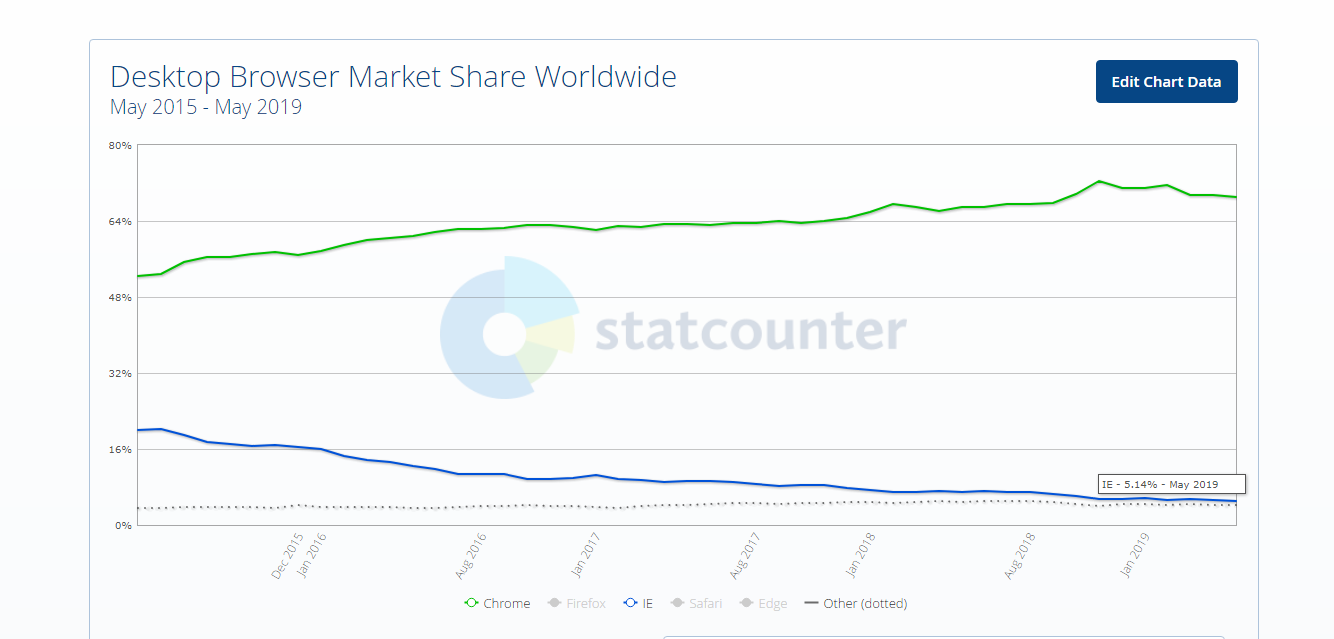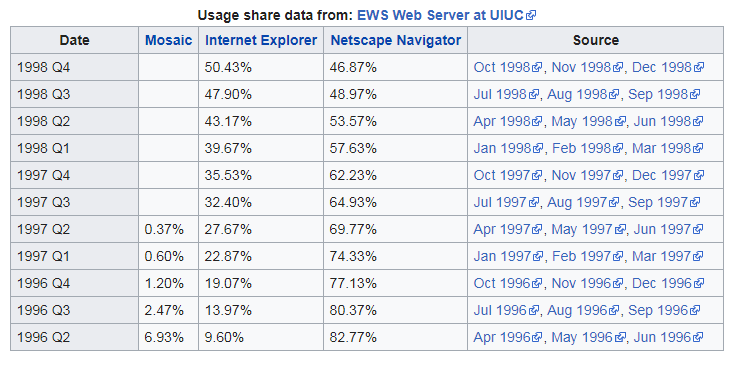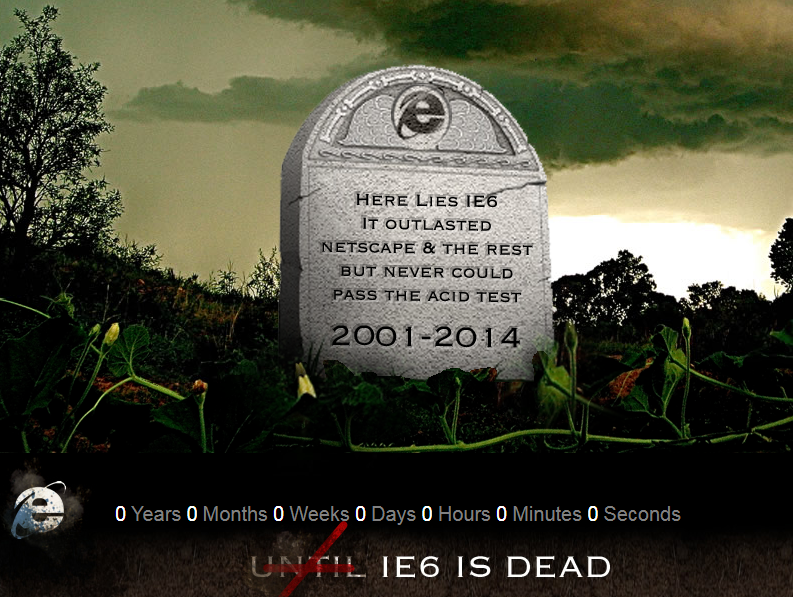Death Of IE; Its Aftermath On Cross Browser Compatibility
Harish Rajora
Posted On: June 10, 2019
![]() 167094 Views
167094 Views
![]() 20 Min Read
20 Min Read
Before starting this post let me ask you one question. When was the last time you used Internet Explorer to browse something? Well, if you have used it recently or if you are using it quite often than the majority of people then this may come as a shock to you.
Microsoft has discontinued IE back in 2015 and now they have officially pulled the plug as well. In a major announcement made by Microsoft, the Teams web app will not support IE 11 as of November 30, 2020. Also, Microsoft 365 services and apps will relinquish their support for IE 11 effective from August 17, 2021. Ever since the 2015 announcement was made, the browser failed to receive any support or update from the community, and there was a gradual drop in the browser market share of IE.

However, as per the above graph is evident that IE still holds a relevant market share of 5.14% by May 2019. And even though the percentage is small in comparison to Chrome which is undoubtedly the topmost utilized browser, the small percentage of IE still accounts for a significant number of users worldwide. It is why IE has been kept in the QA checklist for major enterprises too because nobody wishes to miss out on the potential lead.
Early this year, in Feb 2019, Microsoft security chief, Chris Jackson insisted people to stop using IE as it has been discontinued by Microsoft 3 years back.
Chris Jackson stated,
“Internet Explorer is a compatibility solution. We’re not supporting new web standards for it and, while many sites work fine, developers by and large just aren’t testing for Internet Explorer these days. They’re testing on modern browsers. So, if we continued our previous approach, you would end up in a scenario where, by optimizing for the things you have, you end up not being able to use new apps as they come out. As new apps are coming out with greater frequency, what we want to help you do is avoid having to miss out on a progressively larger portion of the web!”
Chris said so in Microsoft’s blog post “The perils of using Internet Explorer as your default browser”
In this post, we will explore the different sections starting from the factors responsible for the death of IE and how it is affecting the different sections of the people who access the internet. I will take you through the timeline through which this degradation of Internet Explorer has happened. Also, we will consider the cross browser compatibility issues that are arising constantly due to the gradual death of IE. We will also be touching the concept of progressive enhancement and will see how the developers are using progressive enhancements to bring back IE to life. Should we still consider IE in the cross browser testing? We will see. So, let us start the story of IE.
What Led To Death Of IE?
Internet Explorer was a huge hit back in the 90s and the start of the 21st century. But now, it has become a lost hero. There is no surprise in seeing that Internet Explorer has and is losing the market every day because of many factors that we may consider in this post. Some companies have even stopped developing their products for the internet explorer just to save their time and money. We cannot blame them for this step.
You can see that in the image shared at the top that Internet Explorer (as of 2019) captures only 5.14% of the market. This includes all the platform and all the operating systems on the desktop which was the main platform for IE. Why has IE been forgotten? What led to the death of IE? Well, there are a few reasons that are more typical.
Lack Of Features & Slow Updates
The scene is more or less the same if I talk specifics. Internet Explorer has stopped developing new features and even implement the old ones. Even when Internet Explorer was the point of focus for Microsoft, the implementation of features was too slow. Even for those features which have been implemented in other browsers and are in the market for some time now. Some developers felt that the reason for this was that Microsoft used to analyze whether that feature is a hit and worth the investment or not because there are many features in other browsers which are not used by any developer or maybe very few. Some developers had other points of view but I have never seen a strong and loyal community towards Internet Explorer in the past decade. These lack of implementation for updates & features has been a major factor that led to the death of IE.
Edge Grabbing All Of The Limelight
Meanwhile, with the introduction of Windows 10, Microsoft introduced a new browser called Microsoft Edge and promised for it to be fast, reliable, secure and best in the market. Since then, Microsoft has shifted its way towards EDGE browser too much. This shift has led to the slow death of IE. Degradation in the sense that slowly Microsoft stopped the development of new features and enhancement of the existing features. This gradual degradation has led to the slow death of Internet Explorer.
Social Exploitation & Security
Internet Explorer is still used by so many people that Microsoft cannot compromise the security of the browser and hence they just focus on security today when it comes to the Internet Explorer. You must have also noticed on the social media that Internet Explorer is quite common among the meme community for the speed it provides or something else.

Well, even the common people who have never used Internet Explorer do not want to use after seeing such brutal comments for it. They cannot be blamed for this. Anyone would do the same, I guess. Not with respect to browsers, but with anything today. So exploitation on Social media has definitely played a part in the death of IE.
Ruled Out By The Developer Community
Today, the developer’s community is slowly diminishing in terms of the death of IE. If you open the discussion forums on the internet explorer issues or development or anything technically related to it, the posts you will see have aged a lot. Very few discussions are still alive. This directs us to one point, developers have shifted their focus from Internet Explorer and it would not be wrong to say that Internet Explorer is not even considered a priority today for development. If we discuss the features or the upcoming challenges in browsers, Internet Explorer is left out of the discussion. Developing a new feature is developed keeping in mind all the major browsers except Internet Explorer because all the new features include new frameworks which are not understood by the Internet Explorer. But no developer can be blamed for that. After all, it has been discontinued from 3 years now. As a developer, you would also not develop something solely for Internet Explorer based on the fact that the audience has decreased so much, that the time and efforts for it are not worth. So yeah, Microsoft, people and developers all have negative feedback towards Internet Explorer. This is what has led to the death of IE. But this did not happen suddenly in a day. It was a slow process just like a political event. Let us focus on the timeline from the rise of Internet Explorer to see how it went from the most used browser to the most ignored browser today, eventually leading to the death of IE.
Timeline From The Life To The Death Of IE
To know about the effect of Internet Explorer defunct is creating on the world, you need to know what Internet Explorer was once and why is it so important to the developer community. Nothing in this world diminishes in a day. To know the effects, we should know the timeline of events that led to the death of IE.
The Start & Birth
Internet explorer was born in 1995. Back when only one browser was available in the market, Netscape. But the problem with Netscape was that it was not free. You need money to work and invest in efforts. This was not the case with Microsoft. Microsoft already had funds and was ready to invest in the advertisement free of cost. They developed a new browser called Internet Explorer which was free and on the top of it, came pre-installed with Microsoft Windows. It turned out to be the best deal back then as it eventually overtook Netscape Navigator.

The downfall seed was planted in Internet Explorer when they were developing it. Internet Explorer never followed the guidelines of W3C. This was the main authority to decide the guidelines for browsers and websites. Internet Explorer decided to follow their own rules and work on them only. This was fine with the developers until those browsers came into the market who were actually following the guidelines and interpreting the websites on them was far easier than it was on Internet Explorer. The first of them was Opera. This was the point from where the slow death of IE began.
The 21st Century
21st century played a major role in both rising and gradual death of IE. As soon as it was developed, it gained a good majority among the people because of the above-stated reasons. Microsoft Windows gave this browser the best platform that anyone can imagine. An operating system which is in almost every computer was serving this browser free of cost. This continued in the 21st century and in 2003, Internet Explorer became the most popular browser among the people. Although the developers were struggling, people were happy because surfing the internet was everything for which they cared about and they were getting it. This was not the case on the other side. Developers were not happy with the way Internet Explorer wanted things to be. Internet Explorer never cared about the rules and regulations decided by W3C. But, these were followed by the developers to develop the website. Rules were important as they created a universal standard for everyone. Developing something and then rectifying it again for Internet Explorer especially was becoming overwork and a headache for the developers. This was the opportunity that other companies wanted, and they took it at once. They started developing their own browser which favors what developers are demanding. As they devised a plan for the death of IE.
2014 The Death Of IE6
A lot changed after that, Google’s main feature of providing speed through V8 JavaScript engine and the fact that crashing of one tab did not affect any other was well received. This was not available in the Internet Explorer. The main problem for developers in Internet Explorer was the fact that Internet Explorer did not follow the W3C standards. Google Chrome took advantage of it and produced the browser which followed the standards strictly and even passed the Acid 1 and Acid 2 tests. Bringing all this onto the table, they proved a gem for the audience as well as the developers. This brought the start of the decline of the throne of Internet Explorer. The death of IE began in 2014 with IE6.

What Will Be The Aftermath From The Death Of IE?
For software, the saddest part is leaving it without any new features and updates in the ever-growing technical market. This ultimately becomes outdated and left by its loyal users. This is what Internet Explorer is going through. Internet Explorer is dying and it is not a metaphor. This is a real fact. It has reached a point where the majority of its users are those who either are using outdated windows or system are using it. But, since the browser is not one in the market, just like any other product it also has competitors. Whenever something goes down, another competitor picks up. Effects are always visible for such scenarios and Internet Explorer is not an exception. The death of Internet Explorer packs a significant punch.
Cross Browser Compatibility Issues
One of the main steps in developing anything related to the browsers is cross browser compatibility. If you do not know, I will just brief you a little. Cross browser compatibility means the compatibility of a web application or a website to adapt to the rendering differences among different browsers. It should behave in the same way in all browsers as it does on the browser you tested.
Read our blog, If you are not aware of what cross browser compatibility is & why you need it?
So, if you think about it, whenever you are developing a new feature of your website or a whole new website, you will definitely face cross browser issues in Internet Explorer. Internet Explorer is a wild card in the area where rules are to be followed. But, as I mentioned, Internet Explorer is still used by many people today. Although this percentage is very less and minimum in terms of the major browsers, people follow this to reach more audience. The practise of finding cross browser compatibility issues in your website or web-application is termed as cross browser testing. You can perform cross browser testing either manually by interacting with your website through different browsers & OS or you could even opt for automated cross browser testing.
Cross browser compatibility issues remain one of the major headaches for the developers because it is very rare that you develop something in today’s world and pass the IE test smoothly.
Google Chrome & Other Major Browsers
Internet Explorer had gained the market in the late 20th century and Netscape’s browser was seeing a huge decline in its popularity. A huge setback for Netscape, they released their browser code to the open community to save their dying browser. It did not help. To overcome the loss, they decided to form a community called the Mozilla community to develop a browser which is independent, open and standalone.
The release of Firefox saw a huge increase in the popularity and 60 million downloads within 9 months of its release. The Internet Explorer was not wounded by this. The market capture and audience Internet Explorer enjoyed was unparalleled. This phase was ended by Google when they released the Google Chrome browser in 2008 for Windows. This browser was one of its own and Google was prepared to make it the best. They released the browser with the focus on being open source and the tagline Fresh Take on the Browser.
Edge Snatching From IE
Microsoft showed the white flag on Internet Explorer along the back. Microsoft took 5 years to launch IE7 after IE6. One version was taking five years which shows how much they were serious about retaining the market share they were enjoying. By that time Google’s browser and Firefox had captured the market, Microsoft tried to rectify its mistake. They found it really expensive from every angle to rebuild Internet Explorer. It was already infamous. It had already gained a very bad reputation. In 2015, Microsoft came up with Edge for Windows 10, Microsoft brought a new browser called Microsoft Edge and it came pre-installed as a default browser in the new windows. It adheres to the web standards and was built on the engine Chakra. Later in 2017, Edge was released for both Android & iOS. In 2019, Edge was made available for macOS as well. However, As of 2019, Internet Explorer still remains more popular than Edge. The reasons range from the people who are using Internet Explorer because they are stuck on Windows XP or 7. A good number of people see some plugins, extensions, and applications which works fine in IE but not on Edge. This has distributed the audience into two groups. Microsoft tried to gain an audience and keeping the IE audience but instead, they have divided the audience into two groups. Those who use IE and those who use Edge. This has hurt Microsoft even more. To gain the IE audience, Microsoft has shifted its Edge focus from Chakra to Chromium engine. The same engine that is used by Google Chrome to develop its browser. They have also included the use of v8 JavaScript to achieve stability and speed. As of now, Microsoft is rebuilding the Edge to make it compatible with IE applications and plugins.
Microsoft is struggling in the Browser War that the world is fighting. It is hurt, wounded and dying. Keeping to cope up in the market, progressive enhancement is considered the best shot not only for IE but also for the future of web design.
Progressive Enhancement & The Future Of IE
Progressive enhancement is a process of building the basic content of a website which can be viewed/ parsed or should be parsed in every browser. Keeping in mind the cross browser compatibility, progressive enhancement is a very efficient technique in web design where the browser version and the type of browser do not play an important role. So, if you are developing a fancy website and some of whose components are not implemented in an older version of a browser, you do not need to worry about the loss of audience. Anyone who opens the website will be able to see the basic structure and content of the website. Once you are done with the basic structure, you develop other features and fancy attractions on top of it. You can think of it as a layered method where the first layer is the basic layer which is accessible to all. All the top layers are just improving the presentation of website without altering its meaning.
Now you must be thinking that why do we need to have different features for the same website when you can develop the basic structure and launch it. Well, this is where the audience’s interest comes to picture. All the layers that are added are purely due to the way the audience has started to perceive a few things. Apart from development, progressive enhancement plays a vital role while you are testing your website.
Cross browser testing validated the ability of your website and gives you the confidence to launch it on a number of browsers (and versions). While using progressive enhancement, cross-browser testing plays a very vital role. Since your website will be looking different on different versions and browsers (not in a negative way), it is very important that you check the website beforehand. The times of using manual or live methods are gone today and it is not that hectic to test your website for cross browser compatibility issues in JavaScript, HTML, CSS. There are many online tools available like LambdaTest in the market. It is important to remember a few issues that should be checked while you are onto the cross browser testing. You should always keep in mind that not every framework and not every feature of CSS or HTML is implemented in every browser. So, progressive enhancement should be done in a way that even though these things are not supported, they do not affect the basic structure of the website and the meaning the website is trying to convey to the audience.
The introduction & popularity of progressive enhancement delivered the final blow leading to the death of IE as a developer were now comfortable with the fact of unsupported web elements on IE, as long as the basic structure of the website stayed functional.
Is There Any Hope For IE In The Future?
Microsoft has not developed any feature in years for IE. Microsoft has shifted all its focus on Edge. Both of these sentences would mean that Internet Explorer is dying. It is a fact that Microsoft is the manufacturer and destroyer of its browser. Although it started from the basic groundwork that Microsoft did while developing the Internet Explorer, Microsoft is trying hard to kill it. The future of internet explorer seems uncertain to many people but if I have to answer personally, IE will soon be a thing of the past.
From the progressive enhancement perspective, developers have realized that this is a good methodology to reach the audience that uses Internet Explorer. To develop their website using progressive enhancement, they can show the basic structure of the website to the users and retain the complexities for the people using different browsers. Through this method, Internet Explorer has definitely seen a good number of the website being able to render relevant information on it. But, the core of problems that led to the death of IE was the number of issues other than just not being able to implement the features that every other browser is using. This is a matter of great concern and I think it is deducible from the post. There is also another side of the story where Microsoft is trying to bury IE as soon as possible to regain the user base.
Internet Explorer does not have any organization to care about it. It has been on its own from the past 3 years now. It is still hanging in the market just because a huge number of IT firms are still working on Windows 7 or Windows XP. Also, the features of Internet Explorer are yet not working in Edge. But things are changing. Bringing the progressive enhancement into the picture, Microsoft will try to build everything from scratch for the operating systems XP, 7, 8 and 8.1. This will soon see a huge increase in the user base of Microsoft Edge. There is no hiding from the fact that Internet Explorer is slow and quite inefficient. Both in terms of audience and developers. Once the redefined Edge comes into the market, there is a rare chance that Internet Explorer audience will remain loyal to it. The only thing that is binding people to Internet Explorer today is the compulsion or helplessness to use it as they have no other option. This will soon change and will definitely draw the death of IE.
Although, it would take some time or a lot of time to capture the market that once Internet Explorer had by Microsoft. It would also take a lot of time to kill the current browsers by slowly hurting them through new improvements and features. But, it will take very less time for Microsoft to kill its own product by introducing something which is evidently more powerful, more futuristic, faster and reliable. R.I.P Internet Explorer!
Got Questions? Drop them on LambdaTest Community. Visit now















